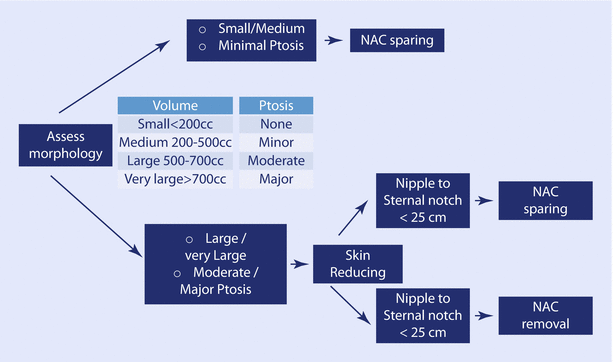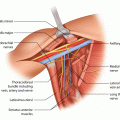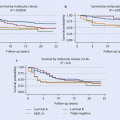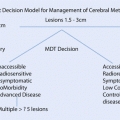Fig. 27.1
Right nipple-sparing mastectomy with immediate reconstruction with latissimus dorsi and implant with post-operative radiotherapy – capsular contracture

Fig. 27.2
Right immediate TRAM flap reconstruction with post-operative radiotherapy
According to the current evidence, radiotherapy has a consistent negative impact on breast reconstruction, and patients should be thoroughly informed of this risk. If the decision is to proceed with the reconstruction, an autologous tissue-based intervention has a higher probability of success. As an alternative, a two-stage (radiotherapy with expander inflated) or an immediate-delayed reconstruction (in case of doubts regarding the need for radiotherapy) would also be considered a possible option. Delaying reconstruction should always be discussed, but patients’ preferences should always be respected once they are fully aware of the possible consequences.
More recently acellular dermal matrices (ADMs) have become increasingly popular in implant-based breast reconstruction. ADMs are products derived from human or animal dermis which has been treated to remove the cellular (antigenic) components. ADMs provide an extra layer of coverage and support for breast implants, particularly over its lower lateral parts. They are used in expander/implant-based breast reconstruction after mastectomy. Radiotherapy seems to have a negative impact in reconstruction with expander/implant and ADMs, but evidence is of very poor quality, and some recent studies start to suggest a decrease in capsular contracture with the use of ADMs [34].
27.5 Impact of Immediate Breast Reconstruction on Quality of Life
While the oncological aspects of breast cancer surgery have been extensively investigated, quality of life after mastectomy and reconstruction have received less attention although the development of good-quality QoL instruments specific to breast cancer outcomes has improved our understanding of these issues considerably in the past decade.
There are now a number of breast-specific QoL tools which have been validated to varying degrees [35]. Among those which have been adequately validated, three (EORTC QLQ BR-23, FACT-B, HBIS) focus on non-surgical treatment issues; the BIBCQ does not address aesthetic concerns after breast reconstruction, and only one, the BREAST-Q, was specifically developed for use in patients undergoing mastectomy and reconstruction. Another tool developed on behalf of EORTC is currently undergoing a process of validation [36].
Using these tools, QoL comparisons have been made between mastectomy and BR versus breast conservation, mastectomy alone versus mastectomy plus reconstruction and skin-sparing versus non-skin-sparing techniques. These are reviewed below.
Heneghan and colleagues [37] reviewed a prospectively collected database in order to evaluate the differences in terms of quality of life between breast-conserving surgery and skin-sparing mastectomy followed by immediate reconstruction. Questionnaires specific for breast cancer were employed (EORTC QLQ B23/B30, FACT-B) to assess patient-reported QoL outcomes. Interestingly both cohorts achieved similar scores in each of the scales used for comparison reporting no significant differences. The authors concluded that skin-sparing mastectomy and immediate breast reconstruction can safely be offered to patients requiring mastectomy with similar outcomes to those who undergo breast-conserving surgery.
This observation was confirmed by a recent [16] survey from the SEER database [16]. They evaluated 1450 patients (963 underwent breast-conserving surgery, 263 mastectomy without reconstruction and 222 mastectomy with reconstruction). They measured quality of life using the FACT-B questionnaire and two measures of patient-reported satisfaction including cosmetic outcomes: one was applied to all patients and one specifically to patients who received breast reconstruction (both derived from existing validated tools). No significant differences in well-being by surgery type were observed when comparing mastectomy plus no reconstruction, breast conservation, and mastectomy and immediate breast reconstruction, except that there seemed to be a greater improvement in physical well-being by the time of the follow-up survey for patients who received mastectomy with breast reconstruction. Among patients receiving mastectomy with reconstruction, radiation receipt was associated with inferior scores for patients receiving implant reconstruction plus radiation therapy. Autologous reconstruction cases fared better. In conclusion, this study confirms that immediate breast reconstruction generates QoL scores not dissimilar from breast-conserving surgery and confirmed the positive role of autologous reconstruction in mitigating the deleterious effects of radiotherapy.
Skin-sparing mastectomies preserving more of the skin envelope and sometimes the nipple have been evaluated in the context of QoL and cosmesis [38, 39]. Patient satisfaction and nipple-areola sensitivity after bilateral prophylactic mastectomy and immediate implant breast reconstruction have been evaluated using the BREAST-Q questionnaire [39]. Interestingly, satisfaction with the (reconstructed) nipple-areolar complex was similar after skin-sparing mastectomies (SSMs ) and nipple-sparing mastectomies (NSMs). Nipple-areola complex sensitivity was lower in the NSM group (mean score, 1.9; 95% confidence interval, 1.5–2.3) compared with the control group – reconstructed nipple (mean score, 4.7; 95% confidence interval, 4.6–4.9; P < 0.01).
Psychosocial and sexual well-being after NSM has also been studied [40] using the BREAST-Q. These results partially contradict the previous study. Two groups of patients (with nipple preservation/without nipple preservation) belonging to a prospectively maintained database were evaluated in multivariate linear regression analysis that controlled for potential confounding factors. Nipple-sparing mastectomy patients reported significantly higher scores in the psychosocial (p = 0.01) and sexual well-being (p = 0.02) domains compared to SSM patients. There was no significant difference in the BREAST-Q domains relating to physical well-being, satisfaction with the breast or satisfaction with outcomes between the NSM and SSM groups.
In conclusion, quality of life after immediate breast reconstruction can be evaluated effectively using several validated tools. Modern reports confirm good results after immediate reconstruction and outcomes comparable to those of breast-conserving surgery. Postmastectomy radiation may compromise patient’s satisfaction, but this negative impact can be diminished with the choice of autologous reconstructions.
Autologous reconstructions are more stable regarding long-term aesthetic outcomes, while implant-based reconstructions tend to decay in the medium to long term. Patients should be correctly informed about these results in order to make a fully informed choice. The benefits of nipple preservation are less well defined with some studies reporting advantages for nipple reconstruction after skin-sparing mastectomy and other studies reporting an increase of physical and sexual well-being with nipple preservation.
27.6 Evaluating Aesthetic Outcomes in Postmastectomy Reconstruction
It is a generalized concept that mastectomy and immediate reconstruction have a better aesthetic outcome than mastectomy with delayed reconstruction. This is probably due to the fact that usually patients submitted to immediate reconstruction have smaller and less aggressive cancers with a lesser need for radiotherapy, and also in this subgroup are the majority of prophylactic mastectomies.
However, as in breast-conserving surgery, there is no standardized objective way of evaluating cosmetic outcomes [41], and in the great majority of cases, cosmetic results are not recorded.
The breast cancer conservative treatment cosmetic results (BCCT.core) software [42] was developed for the evaluation of breast cancer-conserving surgery, and it is not validated for use in breast reconstruction cases. However, objective features like asymmetry and colour differences can be determined even in mastectomy and reconstruction patients.
There is a major need to develop objective tools that will allow us to make meaningful comparisons between techniques allowing the identification of factors that can have a real impact on outcomes [42].
27.7 Decision Algorithms for Postmastectomy Reconstruction Selection
This spectrum of choices and all the factors previously discussed can make the final decision about reconstruction very difficult. Decision algorithms have been widely used to help to make informed selection across a range of breast cancer treatment choices with perhaps the most widely used relating to the decision to have chemotherapy or not (e.g., Adjuvant! Online). Usually in reconstructive surgery, decision algorithms are based on a combination of morphological, clinical characteristics and patients’ preferences [43].
Factors used in the decision process are acquired during the first consultation after cancer diagnosis. The morphological characteristics (height, weight, thoracic perimeter, breast cup size and degree of ptosis) of the patients should be recorded. Breast volume and ptosis can be precisely calculated using models like the ones described by Longo [44] and Kim [45]. With these factors, a simple decision algorithm can help doctors and patients to make more informed decisions (◘ Fig. 3).


Fig. 27.3
Decision tree regarding type of mastectomy (skin sparing or nipple sparing) considering volume and ptosis
The advantage of using decision algorithms is not only to support choices based on more objective factors but also to increase patient engagement in the decision-making process [46]. Medical language is complex, and sometimes patients struggle to understand straightforward medical concepts [47]. For this reason, the use of booklets, photographs and videos of diverse surgical techniques can be very helpful, if the patient feels comfortable and expresses interest to have this type of information. This is normally done during a second or third visit once the complexity of emotional responses engendered by the initial visit has abated somewhat.
27.7.1 Surgical Decision in Patients with Small- and Medium-Sized Breast and Minimal/No Ptosis
In patients with small to medium breast volumes and minimal to moderate ptosis, preservation of the breast skin envelope is usually possible and may include the nipple-areolar complex if oncologically appropriate to do so (nipple preservation is contraindicated in women with tumours close to the nipple, usually defined as less than 10 mm). Reconstruction of the breast mound may be achieved in a variety of ways depending on the patient’s preferences and the availability or otherwise of autologous donor sites. Depending on the patients’ wishes, a contralateral adjustment can be performed in a single stage or as a second stage. Sub-muscular implant reconstructions are less suitable for moderate breast size and moderate ptosis cases where the use of an ADM may be preferable to augment the implant pocket.
27.7.2 Surgical Decisions in Patients with Large and Ptotic Breasts
In these patients, skin preservation i s technically challenging, and several approaches have been described in this situation like the one used by Nava and colleagues [48, 49]. This is a modification of type IV skin-sparing mastectomies as described by Carlson [50] that uses a de-epithelialized dermal adipose flap sutured to the pectoralis major and the fascia of the serratus anterior as a component of a compound pouch in which a permanent implant could be easily allocated (dermal sling technique). The final inverted T scar resulting from this method may be symmetrized by a wise pattern breast reduction or mastopexy on the other side. Nipple-sparing skin-reducing mastectomy is indicated in patients with large or medium breast volumes, but only moderate ptosis. When breast ptosis is significant, the ability to safely preserve the nipple-areolar complex without necrosis is reduced. In those cases, a careful discussion with the patients of a possible free nipple graft in the setting of no postmastectomy radiotherapy or resection of the nipple-areolar complex with a delayed nipple reconstruction should be advised.
27.8 Conclusions
Immediate breast reconstruction has become widely available in modern breast practice with good oncological safety, enhanced cosmesis and quality of life and few absolute contraindications. Radiotherapy does impact on outcomes but should be considered as a relative, rather than an absolute, contraindication. Patients should be fully aware of the consequences before choosing between immediate and delayed breast reconstruction.
In cases of planned immediate breast reconstruction where postmastectomy radiotherapy is likely to be offered, an autologous flap-based reconstruction should be the preferred option. If the patient selects an implant-based reconstruction, a two-stage reconstruction with an expander inflated during radiotherapy and an immediate/delayed reconstruction are also possibilities. The benefits of ADMs in the radiotherapy setting are still unclear, and evidence suggests that while the risks may be lower, radiotherapy is still associated with inferior outcomes.
Stay updated, free articles. Join our Telegram channel

Full access? Get Clinical Tree







